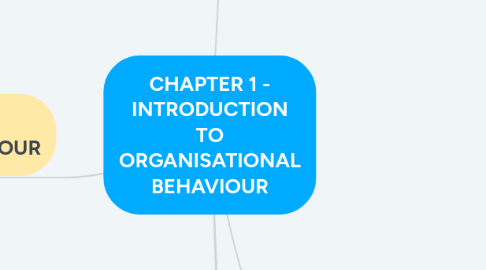
1. ANCHORS OF ORGANISATIONAL BEHAVIOUR
1.1. SYSTEMATIC RESEARCH ANCHOR
1.1.1. Evidence-based management
1.1.1.1. Make decisions and take actions based on research evidence
1.1.2. Individuals and organsiations should
1.1.2.1. be skeptical of hype
1.1.2.2. embrace collective expertise
1.1.2.3. rely on large systematic investications
1.1.2.4. take a neutral stance towards trends
1.2. MULTIDISCIPLINARY ANCHOR
1.2.1. Welcomes theories and knowledge from other disciplines
1.2.2. Related disciplines includes psychology, sociology and anthropology and emerging fields such as communication, marketing and information systems
1.2.3. OB develops own theories but draws from other fields.
1.3. CONTINGENCY ANCHOR
1.3.1. Situational - an action my have a different consequence in different situations
1.3.2. Diagnose the situation and select the best strategy under those conditions
1.3.3. No single solution is best all of the time
1.4. MULTI LEVELS OF ANALYSIS ANCHOR
1.4.1. 3 levels of analysis: Should use all Levels
1.4.1.1. Individual
1.4.1.1.1. Our perspectives
1.4.1.1.2. Motivations
1.4.1.1.3. How we see the world around us
1.4.1.1.4. What role our emotions play
1.4.1.2. Team
1.4.1.3. Organisational
1.4.1.3.1. Reporting
1.4.1.3.2. Relationships
1.4.1.3.3. Power
1.4.1.3.4. Culture
1.4.1.3.5. Organisational change
2. CHALLENGES FOR ORGANISATIONS
2.1. GLOBALISATION - Economic, social and cultural connectivity with people in other pars of the world
2.1.1. ADVANTAGES
2.1.1.1. Lowers costs
2.1.1.2. Increase markets
2.1.1.3. Greater access to knowledge and innovation
2.1.2. DISADVANAGES
2.1.2.1. Reduce job security
2.1.2.2. may be responsible for increasing work intensification
2.1.2.3. Reducing work-life balance
2.2. TECHNOLOGICAL CHANGES
2.2.1. information technology
2.2.2. Automation
2.2.3. AI
2.2.4. Rise of virtual organisations
2.3. WORKFORCE DIVERSITY
2.3.1. SURFACE-LEVEL "what we see"
2.3.1.1. Observable
2.3.1.2. Demographic or physiological differences such as race, age and physical capabilities
2.3.2. DEEP-LEVEL "can't see"
2.3.2.1. Differences in the psychological characteristics of employees, including personalities. beliefs values and attitudes
2.3.3. BENEFITS
2.3.3.1. better and diverse knowledge
2.3.3.2. Improved decision making
2.3.3.3. Discovery of new opportunities
2.3.3.4. Increased financial returns, business performance and customer service
2.3.3.5. more information
2.3.4. CHALLENGES
2.3.4.1. Low effect on innovation - individuals can block what they don't understand
2.3.4.2. Delayed performance effectiveness
2.3.4.3. Communication problems - Interpretation, understanding how people give and receive information, body language and cultural differences
2.3.4.4. May cause: dysfunctional conflict, reduced information sharing and morale
2.4. CHANGING EMPLOYMENT RELATIONSHIP
2.4.1. Work-life balance: The degree to which a person minimises conflict between work and non-work
2.4.2. Remote work: away from the traditional physical work place
2.4.2.1. Provides benefits to employees, companies and the environment
2.4.2.2. Challenges - social isolation and less cohesive with co-workers
2.4.3. Procariate
2.4.3.1. Casual, fixed term and contract work
2.4.3.1.1. Lacking stability - how can someone plan for the future if not sure of income
3. ORGANISATIONAL EFFECTIVENESS
3.1. OPEN SYSTEM PERSPECTIVE
3.1.1. Organisations depend on the external environment for resources.
3.1.2. Organisations effect the environment through their output
3.1.3. Organisations consist of internal subsystems that transform inputs to outputs
3.1.4. Effective organisations
3.1.4.1. Maintain a close 'fit' with changing conditions
3.1.4.2. transform inputs to outputs efficiently and flexibly
3.1.4.3. Actively manage the external environment
3.1.4.4. move to a new sustainable environment
3.2. Efficiency - the amount of outputs relative to the amount of inputs in the organisations transformation process.
3.2.1. Indicator of the internal transformation process and should be:
3.2.1.1. Adaptive
3.2.1.2. Innovative
3.2.1.3. Effective
3.3. ORGANISATIONAL LEARNING PERSPECTIVE
3.3.1. Organisations are effective when they find ways to acquire, share, use and store knowledge
3.3.1.1. FOUR LEARNING PROCESSES
3.3.1.1.1. Acquiring Knowledge
3.3.1.1.2. Sharing knowledge
3.3.1.1.3. Using Knowledge
3.3.1.1.4. Storing knowledge
3.3.2. Can provide a competitive advantage
3.3.3. Organisations can both learn and unlearn
3.3.4. Intellectual capital
3.3.4.1. Human Capital
3.3.4.1.1. -knowledge that people possess and generate - education, work, life
3.3.4.2. Structural Capital
3.3.4.2.1. knowledge captured in systems and structures - procedures, training manuals
3.3.4.3. Relationship Capital
3.3.4.3.1. Value derived from satisfied customers, reliable supplies etc - external to organisation
3.4. HIGH-PERFORMANCE WORK PRACTICES (HPWP) PERSPECTIVE
3.4.1. Workplace practices that leverage potential human capital - work best when bundled together
3.4.1.1. Employee envolvement
3.4.1.1.1. valueing
3.4.1.1.2. involving
3.4.1.2. Job autonomy
3.4.1.3. Employee competence development
3.4.1.3.1. challenging work
3.4.1.4. Reward performance and competencies
3.4.2. Improves effectiveness
3.4.2.1. Develops an employees ability (human capital) and performance
3.4.2.2. Adapt better to rapidly changing environments
3.4.2.3. Strengthen employee motivation and positive attitudes
3.4.3. Can enhance a strong culture and innovation
3.5. STAKEHOLDER PERSPECTIVE
3.5.1. entities that affect, or are affected by the organisations objectives and actions
3.5.2. Relations are dynamic; they can be negotiated, managed, not just taken as a fixed condition.
3.5.3. Generally organisations are more effective when they satisfy stakeholder needs and expectations
4. VALUES, ETHICS AND CORPORATE SOCIAL RESPONSIBILITY
4.1. Prioritise stake holder interests
4.2. VALUES
4.2.1. Stable, evaluative beliefs that guide preferences for outcomes or courses of action in various situattions
4.3. ETHICS
4.3.1. Moral principles and values that determine whether actions are right or wrong and outcomes are good or bad
4.3.2. Represent fundamental values
4.4. CORPORATE SOCIAL RESPONSIBILITY
4.4.1. Benefit society and the environment beyond the firm's immediate financial interests or legal obligations
4.4.1.1. organisations contract with society
4.4.2. Triple bottom line
4.4.2.1. Economy
4.4.2.2. Society
4.4.2.3. Environment
4.4.3. Organisations with positive corporate social responsibility yield better performance
5. INTEGRATIVE MODE OF OB
5.1. Individual inputs and processes influence individual outcomes of organisational effectiveness
5.2. Team processes and outcomes affect individual process and outcomes
5.3. Micro-level influences
5.3.1. Organisational activities
